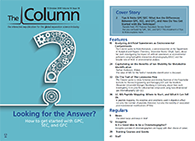LC–MS Peptide Mapping: Where to Start, and What It Can Tell Us
In peptide mapping, the enzymes and conditions used in digestion affect not only the number of peptides liberated, but also the stability of associated post-translational modifications (PTMs).
Photo Credit: Leigh Prather/stock.adobe.com

In peptide mapping, the enzymes and conditions used in digestion affect not only the number of peptides liberated, but also the stability of associated post-translational modifications (PTMs).
To identify or fully characterize a protein biopharmaceutical, it must be broken down into smaller segments or peptides. This process requires proteolytic enzymes to digest the protein into peptides, and is referred to as bottom-up proteomics. A large amount of information can be acquired from biopharmaceutical analysis, including specific post-translational modifications (PTMs) and the protein glycoprofile (the degree and type of glycosylation). However, PTMs can only be isolated to specific amino acid residues when assessed at the peptide level. Great care and consideration is therefore required during the digestion process, because the proteolytic enzymes used and the conditions employed (pH, temperature, and storage time) not only affect the overall number of peptides liberated, but also the stability of associated PTMs, and can even introduce protein modifications of their own.
Broadly speaking, the digestion process can be broken down into three discrete and separate steps: reduction, alkylation, and digestion.
Reduction is commonly accomplished with an acid-labile surfactant that acts to remove the higher order structure of the protein, and exposes internal disulfide bonds ready for reduction by dithiothreitol (DTT), a small-molecule redox reagent. The pH is maintained at physiological levels throughout the process and buffers are used to ensure that the pH levels are appropriate. To prevent reformation of disulfide bridges across the thiol groups of the cysteine (C) residues, the protein is then incubated with an alkylating agent such as 2-iodoacetamide (IAA), once again at physiological pH. The final stage is the addition of a proteolytic agent (trypsin, for example), which is capable of site-specific protein digestion. Trypsin cleaves proteins at the C-terminal side of both lysine (Lys/K) and arginine (Arg/R) residues, unless either is proceeded by a proline (such as KP or RP). For this reason, all resultant peptides, apart from the C-terminal peptide, terminate in either a lysine or arginine residue. Additional and alternative proteolytic enzymes that produce other specific cleavage sites are available and routinely used.
Typical ultrahigh-pressure liquid chromatography (UHPLC)–UV conditions for the separation of the peptides created by digestion follow:
Instrument: UHPLC
Column: 250 mm × 2.1 mm, <2-μm dp fully porous particles (FPPs) or <3-μm dp superficially porous particles (SPPs), C18
Mobile-phase A: 0.05% trifluoroacetic acid
Mobile-phase B: 0.05% trifluoroacetic acid in acetonitrile
Flow rate: 300 μL/min
Gradient: 0–2 min: 1% B, 2–35 min: 1–45% B
Column temp.: 60 °C
UV: 214 and 280 nm
Long (250 mm) but narrow (2.1 mm) high performance liquid chromatography (HPLC) columns, packed with either subâ2-μm FPPs or modern sub-3-μm SPPs bonded with C18 alkyl chain ligands as the stationary phase, are used to generate sufficient peak capacity to separate the large number of peptides created. Typically larger pore sizes (100–300 Å) are used to avoid peak broadening.
Gradients start with very high aqueous, sometimes as high as 100%, and the organic is then ramped up to mid concentrations, typically around 50%, over approximately 30 min. Care is needed to optimize the gradient slope (ramp time) to optimize the separation, and one should note that elution order (selectivity) can be greatly affected by small changes in the gradient ramp rate.
Standard mobile phases are 0.05– 0.1% trifluoroacetic acid in aqueous solution as the polar (A) solvent, and 0.05–0.1% trifluoroacetic acid in acetonitrile as the organic (B) solvent, with trifluoroacetic acid acting to reduce pH to afford good ionization of the peptide, suppress stationary-phase silanol ionization to give good peak shape, and afford retention of the peptides via ion pairing. One should note that lower concentrations or alternative reagents may be required if mass spectrometric detection is required.
The flow rate very much depends on the internal diameter of the column, but volumetric flow rates of 200–300 μL/min for 2.1-mm i.d. columns are the norm. Wider columns will require higher volumetric flow rates to maintain a suitable linear velocity.
Elevated temperatures are common, with 60 °C often favoured to improve mass transfer kinetics and maintain good peak efficiency (sharper peaks). In routine production and QC environments, two detection wavelengths (214 and 280 nm) are typically monitored to give good sensitivity for the various peptide subunits.
More Online: www.CHROMacademy.com/Essentials

New Method Explored for the Detection of CECs in Crops Irrigated with Contaminated Water
April 30th 2025This new study presents a validated QuEChERS–LC-MS/MS method for detecting eight persistent, mobile, and toxic substances in escarole, tomatoes, and tomato leaves irrigated with contaminated water.
Accelerating Monoclonal Antibody Quality Control: The Role of LC–MS in Upstream Bioprocessing
This study highlights the promising potential of LC–MS as a powerful tool for mAb quality control within the context of upstream processing.
University of Tasmania Researchers Explore Haloacetic Acid Determiniation in Water with capLC–MS
April 29th 2025Haloacetic acid detection has become important when analyzing drinking and swimming pool water. University of Tasmania researchers have begun applying capillary liquid chromatography as a means of detecting these substances.

.png&w=3840&q=75)

.png&w=3840&q=75)



.png&w=3840&q=75)



.png&w=3840&q=75)












